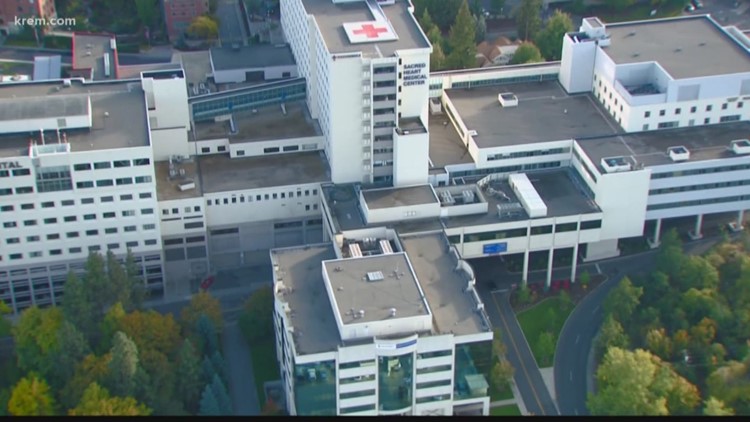SPOKANE, Wash — Coronavirus cases are spiking in Washington, Idaho and around the country and it’s raising concerns about hospital capacity.
Over the last week, Washington broke two records for the highest daily case count, according to data from the Washington State Department of Health. On Nov. 3, Washington saw 1,446 new COVID-19 cases, and on Nov. 5, Washington reported 1,699 new cases.
Idaho health officials reported 955 new confirmed and 237 new probable COVID-19 cases on Tuesday. The state has now topped 1,000 daily cases in seven of the last eight days.
Health officials in Washington state said Tuesday the growing number of cases could put a strain on hospitals around the state as we head into flu season. Health officials in Idaho fear the same.
Here’s what hospitals around the Inland Northwest have to say capacity:
Deaconess and Valley Hospitals
A hospital spokesperson said patient volume changes "hour by hour, minute by minute." As of Monday, Nov. 16, Deaconess and Valley hospitals have capacity to take care of the community.
Multicare Spokesperson Kevin Maloney released this statement:
“As the COVID-19 pandemic has progressed, we have constantly reviewed our approaches to team member and patient safety, to clinical care, and to ensuring access to care for our communities. Because of this, with the increasing numbers of people in our communities testing positive for COVID-19, last week we announced tighter restrictions on visitor access to our hospitals.
"We will continue to proactively adjust our approaches to care to ensure safe access to the services that our patients and communities need and deserve."
As of Friday, Nov. 20, no visitors will be allowed for patients inside Multicare hospitals except for the following:
- Pediatric patients (17 or younger) may have the same two parents or caregivers during their hospital stay.
- NICU patients will be allowed two visitors or caregivers within a 24-hour period
- Family Birth Center patients will be allowed two healthy support people during the labor and birth process. A support person is a spouse or partner, a family member, a friend or a trained doula.
- The support person must be at least 17 years of age, unless they are the parent of the baby or a significant other.
- Two hours after delivery only one support person will be able to remain at the bedside. The second person will be required to leave the hospital.
- The one support person will be the same individual throughout the entire hospital stay.
- Please arrange for care of children, family members and pets in advance so you can focus on your birth and new baby. Patients who are hospitalized before they start active labor and delivery may have one caregiver within a 24-hour period.
- Adult surgical patients may have one visitor for transportation purposes to and from the hospital only.
- Patients who have a mental, developmental or physical disability, such as hearing loss or vision impairment, may have one caregiver for safety.
- Community-based care providers involved in the care of patients may visit for support and care continuity.
- A member of the spiritual community may visit patients, although virtual options are preferred.
- Patients who are at the end of life may have four visitors in a 24-hour period, with two visitors at a time. End-of-life visits from a minor are permissible if accompanied by a parent or guardian and approved by the care team. One immediate family member of end-of-life patient may spend the night, but no sleeping accommodations will be provided.
- Patients who require a home caregiver to be trained may have one visitor in addition to the caregiver, for the training session.
Sacred Heart and Holy Family Hospitals
A hospital spokesperson said they have a “high number” of COVID patients but they still have capacity. They did not offer a percentage regarding capacity at either hospital.
Providence Spokesperson Jennifer Semenza released this statement:
Providence Sacred Heart Medical Center and Providence Holy Family Hospital continuously monitor bed capacity. While the numbers change frequently and we do have a high number of patients with COVID in our hospitals, we still have capacity at this time. The most important thing to know is that if you need care, we can help you.
The community can help relieve stress on area hospitals by utilizing the right level of care for their medical needs.
- Emergency departments are for life-threatening emergencies and severe injuries and illnesses, including major wounds, heart attack, stroke and difficulty breathing.
- Urgent Care locations can care for burns, sprains, minor fractures, stitches, earaches, rash without fever, and abdominal pain
This is also a good time to remind everyone to wear a mask, social distance and don't attend gatherings with people outside of your own home. We are approaching a potentially very busy winter with COVID and flu, and we want to keep our hospitals available for those who need care.
Pullman Regional Hospital
Spokesperson Megan Guido said the hospital has inpatient capacity and they are planning to be in surge readiness for the next six months. Guido said on Thursday, Nov. 12 they had capacity.
Guido also sent this statement to KREM on Friday:
In October, we were frequently at capacity, not just for COVID patients. We were not every day though. We averaged three COVID positive patients a day in October. It has varied so far in November. Hospitals throughout the state and our region, including eastern Washington and northern Idaho, are continuing to be at capacity and challenged to find a bed at other hospitals. We are part of the state-wide DMCC, Disaster Medical Coordination Center, that conducts a daily call to report bed availability throughout the region and state. We use this to assess our ability to transfer patients. Additionally, every day we assess our surge capacity, including regional inpatient bed capacity, level of patient volume and illness, staffing needs, patient care space needs, PPE, supplies and equipment.
Kootenai Health
Kootenai Health Spokesperson Andrea Nagel said the hospital is always working to prepare for what might come next.
As of Friday, Nov. 20, the hospital has 54 patients in its COVID-19 unit and 10 of those patients require critical care.



